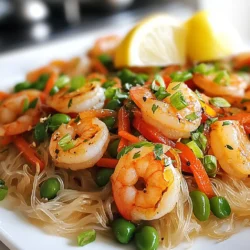
Shrimp Stir Fry Delight
A delicious and quick shrimp stir fry with vibrant vegetables and rice noodles.
Ingredients
- 300 g medium shrimp, peeled and deveined
- 200 g rice noodles
- 2 tablespoons sesame oil
- 1 whole red bell pepper, sliced
- 1 cup snap peas
- 1 whole carrot, julienned
- 3 whole green onions, chopped
- 2 cloves garlic, minced
- 1 tablespoon fresh ginger, minced
- 3 tablespoons low-sodium soy sauce
- 1 tablespoon oyster sauce (optional)
- 1 teaspoon chili paste
- to taste salt and pepper
- for garnish lemon or lime wedges
Instructions
- In a large pot of boiling water, cook the rice noodles according to package instructions until al dente. Drain and set aside.
- In a large pan or wok, heat 1 tablespoon of sesame oil over medium-high heat. Add the shrimp and season with salt and pepper. Cook for about 2-3 minutes until the shrimp turn pink, then remove from the pan and set aside.
- In the same pan, add the remaining tablespoon of sesame oil. Add the minced garlic and ginger, cooking until fragrant (about 30 seconds). Then toss in the sliced bell pepper, snap peas, and julienned carrot. Stir fry for 3-4 minutes until the veggies are tender yet crisp.
- Return the cooked shrimp to the pan, followed by the drained noodles. Pour in the soy sauce, oyster sauce (if using), and chili paste. Toss everything together gently to ensure the noodles, shrimp, and vegetables are evenly coated with the sauces.
- Stir in the chopped green onions and adjust seasoning with extra salt and pepper if needed. Remove from heat and squeeze some lemon or lime juice over the top for a fresh finish.
- Serve the stir fry in bowls, garnished with additional green onions and lemon or lime wedges on the side.
Notes
Adjust the chili paste for desired heat level.